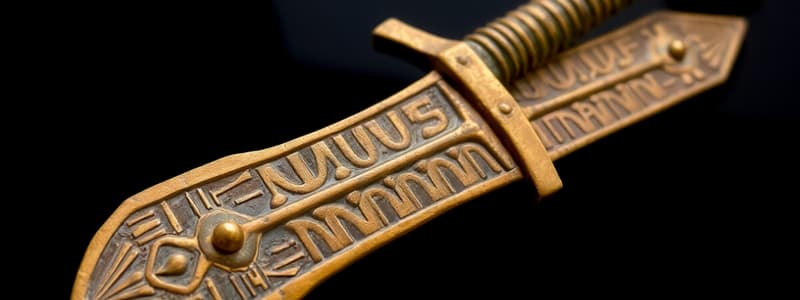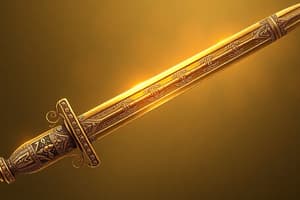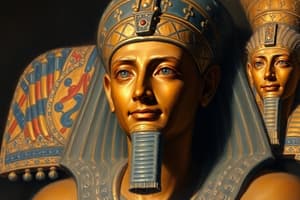Podcast
Questions and Answers
What is the significance of finding Ramses II's insignia on the bronze sword?
What is the significance of finding Ramses II's insignia on the bronze sword?
- It suggests the sword belonged to a high-ranking military official. (correct)
- It indicates the sword was used in religious ceremonies.
- It proves Ramses II personally visited the fort.
- It confirms the sword was imported from another region.
According to Peter Brand, what does the discovery of the sword suggest about the military fort?
According to Peter Brand, what does the discovery of the sword suggest about the military fort?
- The fort was well-defended, possibly with an on-site weapons production area. (correct)
- The fort was poorly defended and easily susceptible to attacks.
- The fort was a civilian settlement with no military significance.
- The fort was primarily used for storing grain and agricultural products.
What do the discoveries of storerooms, ovens, and animal bones at the fort reveal about the daily lives of its occupants?
What do the discoveries of storerooms, ovens, and animal bones at the fort reveal about the daily lives of its occupants?
- They primarily relied on trade with neighboring settlements for sustenance.
- They were primarily focused on religious activities and temple construction.
- They maintained a self-sufficient community with a diverse diet. (correct)
- They practiced a nomadic lifestyle, frequently moving from place to place.
What was the purpose of kohl eyeliner in ancient Egypt, as evidenced by the discovery of an applicator at the fort?
What was the purpose of kohl eyeliner in ancient Egypt, as evidenced by the discovery of an applicator at the fort?
Ramses II's reign is most noted for which of the following?
Ramses II's reign is most noted for which of the following?
What is the potential significance of the two limestone blocks found at the site, one engraved with the name 'Bay' and the other mentioning Ramses?
What is the potential significance of the two limestone blocks found at the site, one engraved with the name 'Bay' and the other mentioning Ramses?
Assuming the sword was presented as a royal gift to a high-ranking officer, which theoretical scenario most plausibly explains its presence within a mud-brick barrack room instead of being prominently displayed?
Assuming the sword was presented as a royal gift to a high-ranking officer, which theoretical scenario most plausibly explains its presence within a mud-brick barrack room instead of being prominently displayed?
If the ratio of grain storerooms to ovens discovered at Tell Al-Abqain is 3:1, and each oven could bake enough bread to feed 15 soldiers daily, while each storeroom held enough grain to feed 120 soldiers daily, for how many days could the fort sustain a population of 360 soldiers, assuming optimal resource management and no additional supplies?
If the ratio of grain storerooms to ovens discovered at Tell Al-Abqain is 3:1, and each oven could bake enough bread to feed 15 soldiers daily, while each storeroom held enough grain to feed 120 soldiers daily, for how many days could the fort sustain a population of 360 soldiers, assuming optimal resource management and no additional supplies?
Flashcards
Ramses II Sword
Ramses II Sword
A bronze sword discovered in Egypt in 2024, marked with Ramses II's insignia.
Ramses II
Ramses II
Ramses II was a powerful pharaoh who ruled ancient Egypt for 66 years (1279-1213 BCE).
Tell Al-Abqain
Tell Al-Abqain
A 3,200-year-old military fort in northwest Egypt where the Ramses II sword was found.
Sword's Significance
Sword's Significance
Signup and view all the flashcards
Fort Defense
Fort Defense
Signup and view all the flashcards
Fort Self-Sufficiency
Fort Self-Sufficiency
Signup and view all the flashcards
Use of Kohl
Use of Kohl
Signup and view all the flashcards
Ramses II's Accomplishments
Ramses II's Accomplishments
Signup and view all the flashcards
Study Notes
- Egyptian archeologists discovered a gleaming bronze sword on September 5, 2024.
Discovery Details
- The sword bears the insignia of Ramses II.
- The sword retains its reflective shine despite being buried for over 3,000 years.
- It was found in a small room within the mud barracks of Tell Al-Abqain, a 3,200-year-old military fort in northwest Egypt.
Significance
- The presence of Ramses II's emblem suggests the sword belonged to a high-ranking military official.
- Historian Peter Brand suggests the fort was well-defended, possibly with on-site weapons production.
- The sword could have been a royal gift to a high-ranking officer, symbolizing status and the king's power.
Other Discoveries at the Fort
- Storerooms for grain and ovens indicate a self-sufficient community.
- Clay pots containing fish and animal bones suggest a diverse diet.
- Bead necklaces and a kohl eyeliner applicator offer insights into the soldiers' personal lives.
- Kohl was used to protect eyes from the desert sun.
- Two limestone blocks were found, one with the name "Bay" and the other mentioning Ramses.
About Ramses II
- Ramses II, also known as Ramses the Great, reigned for 66 years (1279 to 1213 BCE).
- He was the third king of the 19th Dynasty.
- Ramses II expanded Egypt's borders from modern-day Syria to Sudan through military strength.
- He was nicknamed the "builder pharaoh" due to the numerous temples and monuments commissioned during his reign.
Studying That Suits You
Use AI to generate personalized quizzes and flashcards to suit your learning preferences.





